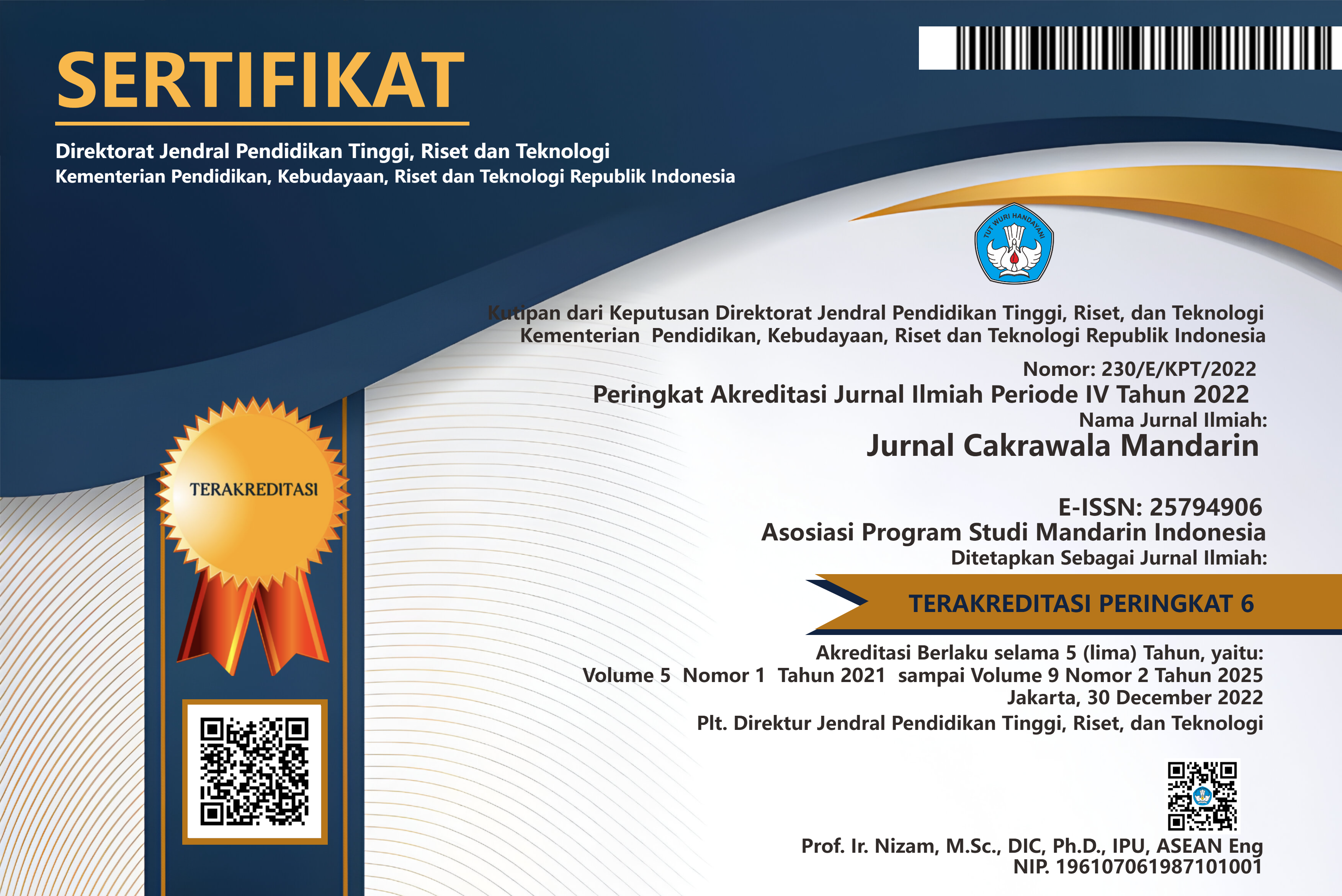印尼本地汉语教师课堂话语分析 —以 Tri Ratna 和 Budi Agung学校两位初中教师为例
Abstract
摘要
课堂上,教师话语是教师组织课堂的一项基本专业技能,教师科学有效的使用课堂话语关系着学生课堂学习的效果。在对外汉语教学中,教师的课堂话语是学习者目的语输入的主要的途径。尤其是在印尼国内教授汉语时,学生处在自己的母语环境中,课堂几乎成为他们接触汉语的唯一场所,因此教师得在课时量不多的情况下,需要不断优化和调整自身课堂话语的使用能力,尽可能多为学生提供开口说汉语的机会,因而透过本研究来了解目前教师的课堂用语情况如何和存在什么样的问题。因此,对印尼 Tri Ratna School 和 Sekolah Budi Agung 两所初中一年级的汉语课堂进行录影,并整理课堂教师话语逐字稿语料,以量化语料标记与统计来厘清方向,再质化参与观察,最后透过对教师访谈来了解课堂的脉络,同时对比课堂话语相关理论,来分析课堂话语量、话语构成类型、课堂提问以及课堂反馈的情况,以作为未来印尼本地汉语教师的反思和本地汉语教师培训的相关参考依据。
关键词: 印尼;汉语教师;课堂话语
Abstract
In the classroom, teacher discourse is a basic professional skill for teachers to organize classes and use lessons scientifically and effectively. Classroom discourse is related to the effectiveness of students' classroom learning. For a foreign language learner, the teacher's classroom discourse is the learner's main way to enter the language. Especially when teaching Chinese in Indonesia, Chinese classes have almost become the only Chinese environment to students. Chinese Teachers have to standardize and adjust their classroom discourse and provide students with as many opportunities to speak Chinese as much as possible. This study started with the videos of the first-grade Chinese language classes at Tri Ratna and Budi Agung high school in Indonesia and organize the corpus of the classroom teacher's discourse verbatim manuscript. Then to quantify corpus markers and statistics to clarify the direction, and re-qualitative participation in observation. Through interviews with teachers, we can understand the context of the classroom. At the same time, we compare the relevant theories of classroom discourse to analyze the quantity of classroom discourse, the types of discourse composition, classroom asking, and classroom feedback. The result will serve as a future local Chinese teacher in Indonesia reflections and references for local Chinese teacher training courses.
Keywords: Indonesia ; Chinese Teacher ;classroom discourse
Full Text:
PDF (简体中文)References
姜丽萍. 教师汉语课堂用语教程[M]. 北京语言大学出版社, 2005, 13-51.
宋如瑜. 华语教师课堂话语发展[M]. 新北市:正中书局, 2020, 73-74,185&211-212.
程国庆. 春风化雨,润物有声——摭谈对外汉语教师课堂话语设计[J]. 河南: 河南理工大学文法学院, 2021 (3): 203-204.
冯至. 对外汉语教师课堂提问技巧探析[J]. 安徽文学: 下半月, 2017 (6): 135-136.
郭睿. 初级汉语综合课教师话语的个案研究——基于两位汉语教师课堂话语语料的分析[J]. 华文教学与研究, 2014 (3): 27-30.
康艳, 程晓堂. 外语教师课堂话语功能新框架[J]. 外语教学理论与实践, 2011 (3): 7.
杨文惠. 试论对外汉语教学中的课堂提问技巧[J]. 中山大学学报论丛, 2006, 26(12): 152-153.
赵晓红. 大学英语阅读课教师话语的调查与分析[J]. 外语界, 1998 (2): 17-21.
朱勇, 佟叶. 国际汉语教师课堂话语难度对比研究[J]. 云南师范大学学报: 对外汉语教学与研究版, 2017, 15(6): 82.
张苗苗.对外汉语教师课堂提问研究[J]. 亚太教育,2016(12):204-205.
戴义凤. 初中数学教师课堂话语比较研究[D]. 云南师范大学, 2018, 23.
李云霞. 对外汉语口语课堂话语互动研究[D]. 东北师范大学, 2017, 17.
林帝娟. 言语行为理论视域下高中英语课堂教师反馈语研究[D]. 集美大学, 2018, 1.
刘菲. 高职高专英语专业综合英语课堂教师话语现状调查与分析[D]. 内蒙古师范大学, 2010, 7.
苗佳佳. 韩国 CPIK 小学汉语教师课堂话语研究[D]. 沈阳师范大学, 2017, 6-8&22.
王红艳. 中学英语课堂教师话语的现状调查分析[D]. 山东师范大学, 2014, 1,18,22-23&26.
王振玉. 初级对外汉语课堂教师提问的分析[D]. 济南: 山东师范大学硕士学位论文, 2013, 33&49.
张掊培. 中级对外汉语综合课教师课堂话语调查与分析[D]. 沈阳大学, 2020, 83-85.
赵珍珍. 对外汉语课堂教师提问对学生口语输出的影响研究[D]. 北京外国语大学, 2017, 21-22.
Arif Budiman. Bahasa Mandarin Makin Populer di Indonesia (voaindonesia.com), 2020.
Cakap. Mengapa Si Kecil harus Belajar Bahasa Mandarin? (blog.cakap.com), 2022.
附录
附录1——教师A的课堂视频及逐字稿链接
https://drive.google.com/drive/folders/14S850ZAEXRDfEgfjRAu9ZlELtX1gNghU?usp=sharing
附录2——教师B的课堂视频及逐字稿链接
https://drive.google.com/drive/folders/1t1sWs1Q3qedOrqcdaLvLaPhHyQbc8Ag1?usp=sharing
DOI: http://dx.doi.org/10.36279/apsmi.v6i2.219
DOI (PDF (简体中文)): http://dx.doi.org/10.36279/apsmi.v6i2.219.g123
Refbacks
- There are currently no refbacks.
Alamat Redaksi: Tlp. +62778473399 - hermanuvers72@gmail.com E-ISSN 2579-4906 |  |




